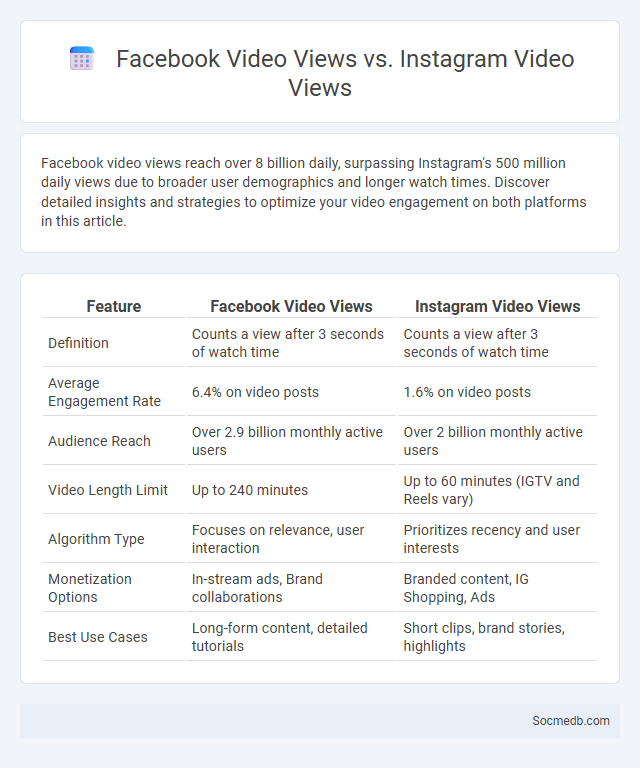
Photo illustration: Facebook Video Views vs Instagram Video Views
Facebook video views reach over 8 billion daily, surpassing Instagram's 500 million daily views due to broader user demographics and longer watch times. Discover detailed insights and strategies to optimize your video engagement on both platforms in this article.
Table of Comparison
| Feature | Facebook Video Views | Instagram Video Views |
|---|---|---|
| Definition | Counts a view after 3 seconds of watch time | Counts a view after 3 seconds of watch time |
| Average Engagement Rate | 6.4% on video posts | 1.6% on video posts |
| Audience Reach | Over 2.9 billion monthly active users | Over 2 billion monthly active users |
| Video Length Limit | Up to 240 minutes | Up to 60 minutes (IGTV and Reels vary) |
| Algorithm Type | Focuses on relevance, user interaction | Prioritizes recency and user interests |
| Monetization Options | In-stream ads, Brand collaborations | Branded content, IG Shopping, Ads |
| Best Use Cases | Long-form content, detailed tutorials | Short clips, brand stories, highlights |
Introduction to Video Views: Facebook vs Instagram vs General
Video views on social media platforms vary significantly, with Facebook boasting over 8 billion daily video views and Instagram generating more than 500 million. Your choice between Facebook and Instagram for video content should consider audience demographics, as Facebook caters to a broader age range while Instagram attracts younger users aged 18-34. Understanding the general trend of increasing video consumption on both platforms can optimize content reach and engagement.
Defining Facebook Video Views: Metrics and Importance
Facebook video views measure the number of times a video is watched, with key metrics including 3-second views, 10-second views, and average watch time, which indicate viewer engagement levels. These metrics are crucial for marketers and content creators to evaluate video performance, optimize content strategy, and improve audience targeting. Tracking Facebook video views helps in understanding user interaction patterns and boosting overall reach and brand visibility on the platform.
Understanding Instagram Video Views: How They’re Counted
Instagram video views are counted when your video has been watched for at least three seconds, providing a reliable measure of genuine engagement. This metric applies to videos posted on the feed, Stories, IGTV, and Reels, ensuring consistency across formats. Knowing how Instagram counts views helps you accurately assess Your content's performance and optimize your social media strategy.
What Is a Standard Video View? Industry Benchmark
A standard video view on social media typically counts when a user watches at least three seconds of a video, aligning with industry benchmarks set by platforms like Facebook and Instagram. This metric helps advertisers gauge initial engagement levels and compare video performance across campaigns. By understanding your video view thresholds, you can better optimize content strategy to increase viewer retention and maximize advertising ROI.
Engagement Rates: Facebook vs Instagram Video Views
Instagram video views typically generate higher engagement rates compared to Facebook, driven by Instagram's algorithm prioritizing video content and the platform's younger, more interactive audience. Facebook's video engagement tends to benefit from broader demographic reach but often sees lower average watch times and interaction levels. Brands leveraging Instagram's video features like Reels and Stories experience increased likes, comments, and shares, boosting overall engagement metrics significantly.
Audience Demographics: Platform-Specific Insights
Facebook's user base primarily includes adults aged 25-54, with a strong presence in the 35-44 age group, making it ideal for businesses targeting mature audiences. Instagram attracts a younger demographic, mostly between 18-34 years old, emphasizing visual content that appeals to Millennials and Gen Z. TikTok dominates among teenagers and young adults aged 16-24, with rapid engagement driven by short-form video content and trends.
Video Content Types: What Works on Each Platform
Video content types vary in effectiveness depending on the social media platform; Instagram favors short, visually appealing Reels, while YouTube thrives on longer, informative videos that engage viewers deeply. TikTok success relies heavily on quick, trendy clips that promote shareability and viral potential, whereas Facebook performs well with live streams and community-centered videos that encourage interaction. Tailoring your video content to the strengths of each platform ensures higher engagement and better audience retention.
Video Algorithms: How Facebook and Instagram Calculate Views
Facebook and Instagram calculate video views based on user engagement metrics such as watch time, video length, and interaction rates. Both platforms prioritize videos that retain viewers for longer durations and encourage active participation through likes, comments, and shares. Their algorithms also factor in viewer history and relevance to optimize content distribution and maximize reach.
Advertising Effectiveness: Facebook vs Instagram Video Ads
Facebook and Instagram video ads differ in audience engagement and ad performance metrics, with Instagram often showing higher click-through rates and better reach among younger demographics. Your advertising budget tends to stretch further on Facebook due to its broader user base and diverse targeting options, enhancing conversion potential. Analyzing platform-specific insights allows you to optimize ad creatives for maximum effectiveness in driving brand awareness and sales.
Best Practices for Maximizing Video Views Across Platforms
Optimizing video content with platform-specific features, such as Instagram Reels, TikTok's For You Page algorithms, and YouTube's SEO-friendly titles and descriptions, significantly boosts visibility and engagement. Employing strong thumbnails, concise captions, and strategic hashtags enhances discoverability across social networks. Consistent posting schedules paired with audience interaction analytics drive sustained growth and increase video view counts effectively.
 socmedb.com
socmedb.com